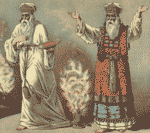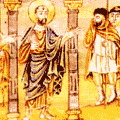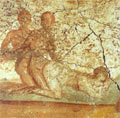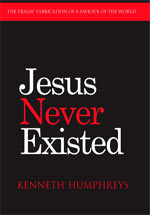He who has ears
Let him hear!
5-minute enlightenment
for those in a hurry
The Jewish Cauldron
The Judaean state was the quintessential theocracy. The priesthood controlled all aspects of Jewish life and the humble Jew was totally at the mercy of the priest.
Occupation by, and war against, Rome sent seismic waves through the cohorts of piety.
Between the fall of the Jerusalem Temple in 70 and the final routing of the Jews in 135, many strains of revisionist Judaism contended.
Coptic monks
It should surprise no one that after the failure of the final Bar Kochbar rebellion and the abolition of Judaea, factions of Judaism should metamorphose into a 'new' religion – Christianity.
Paul – Gnostic or Not?
Party time in Corinth?
It seems the early Christians of this Greek city took "love one another" a bit too literally. Both Paul and Clement castigated the Corinthians for their promiscuity.
"It is reported commonly that there is fornication among you, and such fornication as is not so much as named among the Gentiles, that one should have his father's wife...
Concerning him that hath so done this deed, In the name of our Lord Jesus Christ deliver such one unto Satan for the destruction of the flesh, that the spirit may be saved."
– 1 Corinthians, 5.1,5.
Early Christians: penchant for unclean coupling?
Holy Hare! Multiple Orifices!
"Among other things, the Lord says, you are not to eat of the hare, by which he means you are not to debauch young boys, or become like those who do; because the hare grows a fresh orifice in its backside every year, and has as many of these holes as the years of its life."
– Epistle of Barnabas, 10
An obvious serial pederast
Holy Sex Change!
" 'And you are not to eat the hyena' signifies that you are to be no lecher or libertine, or copy their ways; for that creature changes its sex annually and is a male at one time and a female at another."
– Epistle of Barnabas, 10
Watch out for this sex-change menace.
"BJ" Barnabas
"Neither shalt thou cleave unto impure women who work iniquity with their mouth."
– Epistle, 10:8

No cleaving here.
Papias
"If anyone happened to come who had actually been a follower of the Elders, I would inquire about the sayings of the Elders ...
For I thought that things from books did not benefit me as much as the sayings of a living and abiding voice...
The Elder also used to say this:
Mark had been the interpreter for Peter. And he wrote down as much as Peter told of the sayings and deeds of Christ – accurately, but not in order.
For he was not a hearer or follower of the Lord but, as I said, of Peter, who adapted his teaching as needed and did not arrange the sayings of the Lord in an orderly manner.
So, then, Matthew compiled the Sayings of the Lord in the Hebrew language. But everyone interpreted them as he could."
– Eusebius (Hist. Eccl.)
Nicolaitans?
"Saved by grace, free from the law, nothing forbidden."
Irenaeus provides the earliest reference (apart from the book of Revelation) to this promiscuous band of early Christians of Roman Asia. Apparently, "they lead lives of unrestrained indulgence."
Naughty, naughty.
From the beginning of human civilization priests and 'holy men' have invented pious nonsense. For the priesthood the rewards have been immense: power, prestige and wealth. They have fused with, and become part of, the ruling elite. But times of social stress have always seen the emergence of a counter-priesthood, radicals or fundamentalists, preaching a purity of fable; ascetics, puritans and fanatics who revile and castigate a corrupt and worldly religious establishment and offer themselves as apostles of Truth and Divine Wisdom. Rome's 1st century colonisation and exploitation of Judaea placed huge stresses on a theocracy that had enjoyed absolute power under the Maccabean kings and had been placated and indulged even by Herod the Great. Pharisees on the one hand – rabbinic guardians of a religious correctness, not part of the Temple hierarchy– and Essenes on the other – egalitarian purists, who withdrew to their own communities and lived by their own rule – trained the cadres, and fashioned the earliest ideology, for a radical recasting of Judaism. A century of endemic rebellion, civil war, and wars of national resistance, leading ultimately to catastrophic defeat, made ready the seed bed for a violent and profound religious revolution.
Prophets of Doom The earliest Christian communities, remote from power and lacking in wealth, were led by charismatic agitators, peripatetic "prophets" and "teachers" who claimed their doom-laden message was received directly from the Holy Spirit of God (Acts 13.2; 15.23, etc., confirms as much). Their doctrine was spontaneous, variable and idiosyncratic. Tellingly, the handful of late 1st century / early 2nd century writers (Paul, Clement, Barnabas, Papias) did not quote Jesus at all. They say nothing, or next to nothing, of humanoid "Jesus actions" or miracles. The virgin-born, miracle-working, godman of later legend was unknown to them. When their fantasy required the endorsement of higher authority they turned instead to Jewish scripture, to the patriarchs, the prophets and the supposed utterances of the Jewish God himself.
The Enigma of "Paul"
Pared down to its essentials Paul's gnostic logic argued: from time immemorial "Christos" had been the Son of God. This Christos had sacrificed himself in a remote past in order to be reborn within man. His "resurrection" and "life" are realized again within initiates such as Paul himself and those who accept him. It surely is a tad more than curious than none of the other documents more or less contemporary with Paul's epistles – Shepherd of Hermas, Didache, 1 Clement, Revelation of St John, epistle to the Hebrews, epistle of Barnabas – say anything from the "Jesus of Nazareth" fairy tale known to every child today. Is it not more than reasonable to suggest that at this stage the story had not yet been fabricated?
"Clement of Rome"
5th century fantasy invented a colourful martyrdom for the guy, involving drowning in the Black Sea with an anchor round his neck and a sub-marine shrine built by angels. The fable probably owed much to a confusion with his namesake, Titus Flavius Clemens, a consul executed by Emperor Domitian. The confusion is further compounded by the common assumption that Clement's reference to the "recent misfortunes" of the Roman Church relates to a supposed persecution instigated by Domitian. But this "persecution" is bogus and Clement actually makes no mention of martyrdom even when it refers to the deaths of Peter and Paul. Whoever he really was, Clement is credited with the most important Christian text outside the New Testament – his First Epistle, a document which is primarily concerned with remonstrating with the brethren in Corinth who had deposed their presbyters. (Perhaps too readily they had seen through the priestly fraud!) Examined closely, the epistle is clearly less of a genuine letter and more a tract on maintaining communal discipline and priestly authority. It attributes to the Apostles themselves foreknowledge of career rivalry among Christians – who consequently institute "Apostolic succession" to maintain the peace of the Church (Clement 44). This alone suggests a 2nd century date. The epistle, important as it is in the gathering up of papal authority, says nothing of an historical Jesus. Its fancies include reference to the "500-year-old phoenix bird". "Clement" (or, rather, the coterie of pseudonymous fraudsters) authored further nonsense throughout the 2nd, 3rd and 4th centuries, notably the Clementine Recognitions.
"Barnabas" Supposedly, Barnabas was a sometime travelling companion of Paul.
Barnabas quotes, repeatedly and often inaccurately, diverse Old Testament worthies, Enoch, Daniel, Moses, etc., and always to the effect "this really refers to Jesus." Jewish dietary laws ("thou shalt not eat the hare ... neither shalt thou eat the hyena"), animal sacrifice, the land of milk and honey – all are imaginatively reinterpreted as nothing other than allegorical references to Christ. But the Jews themselves have been "seduced by evil" and are beyond the pale. Like the 'Shepherd of Hermas' and the 'Didache' (from which the epistle borrows its Light and Dark 'Two Ways'), Barnabas is early anti-Jewish Christian propaganda which, during the course of the second century, lost its usefulness. Only obliquely, does Barnabas refer to certain motifs of the familiar Jesus Christ pageant:
But nowhere does Barnabas quote or cite any Christian "gospel". No apostles are named, no Holy Family configured. The pageant at this stage is a work-in-progress. Indeed, Barnabas vigorously rejects the idea that Christ is the "son of David" – which it describes as an "error of sinful men." Is Christ, perhaps, an anthropomorphic Sun God? The countenance is certainly sun-like:
In short, this entertaining epistle illustrates how the early to mid-2nd century was a most creative phase in the fabrication of the Jesus legend. A 'Gospel of Barnabas' (inevitably) made an appearance in the Middle Ages, perhaps based on an ancient original. Some Muslims like to think so. Its Jesus is no more than a man; Judas is the one crucified; and the gospel anticipates the coming of Muhammad!
"Papias" Papias, a Christian bishop of Hierapolis, Phrygia in Asia Minor about the year 130, collected and analysed the "sayings and deeds of the Lord", and yet he was unfamiliar with the gospels. He also appears to have been unaware of St Paul's Epistles even though he lived a few miles from Colossae. He reports merely that Mark "wrote down what he remembered." Eusebius, orthodoxy's 4th century propagandist, was dismayed by this early bishop. He described the parables of Papias as "strange" and his reported teachings of the saviour as "of a fabulous character." Papias is the author of some entertaining tales about the villainous Judas Iscariot. Eusebius damns this inconvenient witness to Christianity's inventiveness by calling him "a man of exceedingly small intelligence." (Eusebius, Hist. Eccl. 3.39.13).
The literature of the world is filled with invented characters. With good reason it is called fiction. Jesus did not produce the Church. The Church produced its own self-serving fiction: the story of Jesus. In the early decades of the 2nd century, that is within less than a hundred years of the supposed life and death of a human saviour, the Christians that we know of were propagating the cause of a wholly spiritual Christ. If this Christ were accorded a life at all, it was in mythic "ancient times." In the two centuries that followed, a number of individuals contributed to the process of anthropomorphizing their celestial hero into the flesh and blood miracle-worker known to all. "Jesus of Nazareth" never lived but his life was invented to underpin adoration of the ineffable cosmic Christ and obedience to his worldly taskmaster, Holy Mother Church. That Christ would also grow, in step with the authority and majesty of the Church, from an 'emanation' or messenger of God into an eternal, co-creator of the universe. But it was not the aeons of ethereal eternity that would be turned into a pageant for the lost and gullible. In the scattered communities, ghettoes, and slums of the Roman Empire it was an ancient tale of sacrifice and re-birth that would be dressed up in new Christian clothes.
Sources:
Enlighten a friend e-mail this page
Copyright © 2005
by Kenneth Humphreys.
|
|||||||||||||||||||||||||||||||||||||||||||||||||||||||||||||














